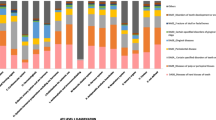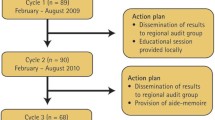Abstract
Aim of study To analyze dental prescribing errors in Aracaju, Brazil, and to suggest feasible improvements for patient safety. Methods A descriptive study was conducted at nine Primary Health Care Units (PHCUs) in the northeast region of Brazil. A convenience sample of 300 dental prescriptions was selected during the period February–May 2007. The World Health Organization (WHO) prescribing criteria were used to measure the quality of the prescriptions. Main outcome measures All medications were prescribed by generic name; 98.3% of prescription information contained abbreviations and 26% of them were classified as having low legibility or as being illegible. The most commonly prescribed medications were diclofenac (35%), both sodium and potassium, and amoxicillin (26%). Conclusions Dental prescribing errors should be considered as a potential area for improvement in the medication management process and patient safety. We suggest that a pharmacist should be available for medication dispensing at all units and that dentists are trained continuously so that medication orders may become more legible and complete. Improving the quality of dental prescriptions will reduce the risks for medication errors and will promote the rational use of pharmacotherapy, and patient safety.
Similar content being viewed by others
References
National Coordinating Council for Medication Error Reporting and Prevention (NCCMERP). Council recommendations. Recommendations to reduce medication errors associated with verbal medication orders and prescriptions. NCCMERP; 2001. Available online at: http://www.nccmerp.org/council/council2001-02-20.html.
Bates DW, Spell N, Cullen DJ, et al. The costs of adverse drug events in hospitalized patients. JAMA. 1997;277(4):307–11.
Kohn LT. The Institute of Medicine report on medical error: overview and implications for pharmacy. Am J Health Syst Pharm. 2001;58:63–6.
Dean B, Schachter M, Vincent C, et al. Prescribing errors in hospital inpatients: their incidence and clinical significance. Qual Saf Health Care. 2002;11(4):340–4.
Otero-López MJ. Errores de medicación y gestión de riesgos. Rev Esp Salud Publica. 2003;77(5):527–40.
Shulman R, Singer M, Goldstone J, et al. Medication errors: a prospective cohort study of hand-written and computerised physician order entry in the intensive care unit. Crit Care. 2008;9(5):R516–21.
Winterstein AG, Johns TE, Rosenberg EI, et al. Nature and causes of clinically significant medication errors in a tertiary care hospital. Am J Health Syst Pharm. 2004;61:1908–16.
Buurma H, De Smet PA, Leufkens HG, et al. Evaluation of the clinical value of pharmacists’ modifications of prescription errors. Br J Clin Pharmacol. 2004;58(5):503–11.
Kohn LT, Corrigan JM, Donaldson MS. To err is human: building a safer health system, 2nd edn. Washington: National Academy of Sciences; 2000. ISBN-13: 978-0-309-06837-6.
Runciman WB, Roughead EE, Semple SJ, et al. Adverse drug events and medication errors in Australia. Int J Qual Health Care. 2003;15(1):i49–59.
Florida Health Care Coalition (FHCC). POP campaign employer guide. 2004. Available online at: http://www.flhcc.com/docs/POP%20Campaign%20Employer%20Guide.pdf.
Cohen HE. Seniors are the risk for medical errors in hospitals. US Pharmacist. Janeiro. 2004.
Miasso AI, Oliveira RC, Silva AEBC, et al. Prescription errors in Brazilian hospitals: a multi-centre exploratory survey. Cad Saude Publica. 2009;25(2):313–20.
Néri EDR. Determining key factors related to errors in medication prescribing in university hospital. Masters degree dissertation, Faculty of Pharmacy, Odontology and Nursing, Federal University of Ceará; 2004.
Lyra DP Jr, Prado MCTA, Abriata JP, et al. Prescription orders as cause of risk of drug-related problems. Seguim Farmacoter. 2004;2(2):86–96.
Gómez-Oliván LM, Márquez Rodríguez S, Pontigo Loyola P, et al. The prescription of drugs in a dental clinic of a Mexican university hospital. Farm Hosp. 2007;31(3):169–72.
Ogunbodede EO, Fatusi OA, Folayan MO, et al. Retrospective survey of antibiotic prescriptions in dentistry. J Contemp Dent Pract. 2005;6(2):64–71.
Castilho LS, Paixão HH, Perini E. Prescription of drugs of systemic use by dentists. Rev Saude Publica. 1999;3:287–94.
Winslow EH, Nestor VA, Davidoff SK, et al. Legibility and completeness of physicians’ handwritten medication orders. Heart Lung. 1997;26:158–64.
Anacleto TA, Perini E, Rosa MB, et al. Medication errors and drug-dispensing systems in a hospital pharmacy. Clinics (Sao Paulo). 2005;60(4):325–32.
de Vries TPGM, Henning RH, Hogerzeil HV, et al. Guide to good prescribing. A practical manual. Geneva: World Health Organization Action Programme on Essential Drugs. WHO/DAP/94.11; 1994. Available online at: http://whqlibdoc.who.int/hq/1994/WHO_DAP_94.11.pdf.
Shrank WH, Hoang T, Ettner SL, et al. The implications of choice: prescribing generic or preferred pharmaceuticals improves medication adherence for chronic conditions. Arch Intern Med. 2006;166:332–7.
Vaida AJ, Peterson J. Incomplete directions can lead to dispensing errors. Pharm Times. 2002;5:34–8.
Brunetti L, Santell JP, Hicks RW. The impact of abbreviations on patient safety. Jt Comm J Qual Patient Saf. 2007;33(9):576–83.
Noto AR, Carlini EA, Mastroianni PC, et al. Analysis of prescription and dispensation of psychotropic medications in two cities in the state of São Paulo, Brazil. Rev Bras Psiquiatr. 2002;24(2):68–73.
Neto C, et al. Society for Healthcare Epidemiology of America (SHEA). SHEA; 2000. Available online at: http://www.anvisa.gov.br/farmacovigilancia/oficinas/oficina_2/apresentacoes/0804_10h30_marciapinto.ppt.
Gimenes FRE, Miasso AI, Lyra DP Jr, et al. Electronic prescription as contributory factor for hospitalized patients’ safety. Pharm Pract. 2006;4(1):13–7.
White WB. Cardiovascular effects of the cyclooxygenase inhibitors. Hypertension. 2007;49:408–18.
Ciancio S, Reynard A, Zielezny M, et al. A survey of drug prescribing practices of dentists. N Y State Dent J. 1989;55:29–31.
Berquó LS, Barros AJD, Lima RC, et al. Use of antimicrobial drugs in an urban population. Rev Saude Publica. 2004;38:239–46.
Battellino LJ, Bennun FR. Information level and pharmacotherapeutic practice of dentists, 1990. Rev Saude Publica. 1993;27:291–9.
Duarte MAH, Vale IS, Garcia RB. Using antibiotics in endodontics. Rev Assoc Paul Cir Dent. 1999;53(1):59–62.
Abrantes PM, Magalhães SMS, Acúrcio FS, et al. Quality assessment of antibiotic prescriptions dispensed at public health units in Belo Horizonte, Minas Gerais, Brazil, 2002. Cad Saude Publica. 2007;23(1):95–104.
Lilley LL, Guanci R. Unfamiliar drug uses. Am J Nurs. 1995;95(1):15.
Arrais PSD, Barreto ML, Coelho HLL. Drug prescription and dispensing from the patient’s perspective: a community-based study in Fortaleza, Ceará State, Brazil. Cad Saude Publica. 2007;23(4):927–37.
Pharmacy Manual Policy Guidelines (PMPG). PMPG; 2007. Available online at: http://12.23.28.50/ProviderManuals/Pharmacy/PDFS/Pharmacy_Policy_Guidelines.pdf.
Burke J. Prescription drug abuse trends, part II: class 4. Pharm Times. Available online at: http://www.pharmacytimes.com/issue/pharmacy/2002/2002-06/2002-06-6924.
Sprenger G. Sharing responsibility for patient safety. Am J Health Syst Pharm. 2001;58:988–99.
Thompson KK. Learning from errors begins with reporting them. Am J Health Syst Pharm. 2001;58:567.
Pepe VLE, Castro CGSO. Interaction between prescribers, dispensers, and patients: shared information as a possible therapeutic benefit. Cad Saude Publica. 2000;16(3):815–22.
Acknowledgments
The authors acknowledge the valuable comments of Prof. Alfredo Dias Oliveira Filho and Prof. Chiara Ermínia da Rocha.
Funding
This study was supported by the CAPES.
Conflicts of interest
There are none.
Author information
Authors and Affiliations
Corresponding author
Rights and permissions
About this article
Cite this article
Mendonça, J.M.D., Lyra, D.P., Rabelo, J.S. et al. Analysis and detection of dental prescribing errors at Primary Health Care Units in Brazil. Pharm World Sci 32, 30–35 (2010). https://doi.org/10.1007/s11096-009-9335-7
Received:
Accepted:
Published:
Issue Date:
DOI: https://doi.org/10.1007/s11096-009-9335-7




